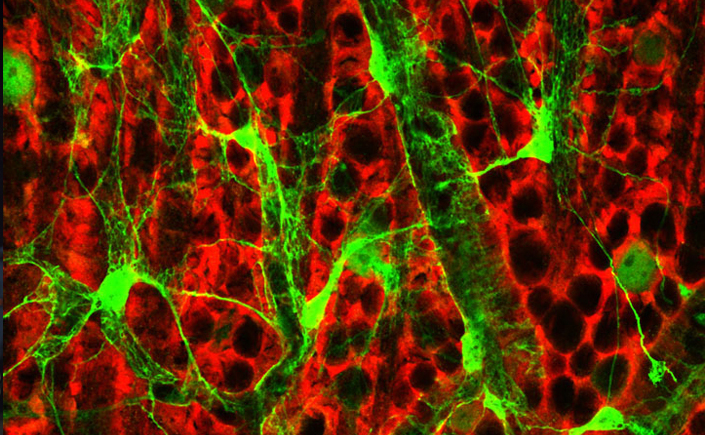
After a stroke, blood flow through capillaries is hard to restore, even when the blood clot is removed. In Alzheimer’s disease, blood flow to some brain areas is compromised. In diabetic retinopathy, diabetes patients’ retinas deteriorate. The problem may be a compromised blood supply that can’t meet the demands of neurons.
In all these conditions, neurons are starved for the oxygen and glucose they need to function properly. Normally, when neurons in the brain or retina are working and need extra nourishment, some type of signal prompts nearby blood vessels to dilate and let more blood through. Pinpointing the nature and origin of such signals is critical to finding treatments for conditions in which it is lost or weakened.
But the signals don’t necessarily pass directly from neurons to blood vessels. University of Minnesota researchers have shown that in the retina, cells called glia—Latin for “glue”—respond to neuronal activity by signaling capillaries within the retina to dilate, increasing capillary blood flow by up to 26 percent. Their report is a cover story for the Journal of Neuroscience.
“Neurons were previously thought to do all the information processing and signaling, and glial cells the housekeeping, says Eric Newman, a professor in the Department of Neuroscience and senior author on the paper. “But within the brain, glia, too, have essential functions in information processing and signaling.”
Calcium is Key
In their research, Newman and his colleagues shined light on mouse retinas in order to activate neurons. The active neurons then prompted retinal glia, called Müller cells, to send a “dilate” signal to capillaries in the vicinity.
The signaling begins when active neurons stimulate Müller cells, causing calcium increases within the glial cells. The calcium increases trigger the release of other chemicals onto nearby cells called pericytes. Encircling capillaries like a blood pressure cuff, the pericytes respond by easing the pressure and dilating the capillaries.
Calcium signaling by Müller cells was known, but researchers have disagreed as to whether it is necessary and sufficient for capillary dilation. Newman and colleagues demonstrated that it is: When they specifically blocked the calcium increases, the capillary dilation also disappeared.
“A glial cell can sense the activity of many neurons in its neighborhood,” Newman notes. “In a sense, glial cells are taking the pulse of neurons in a wide area.”
Brain and Beyond
Newman will repeat this work in the brain to find out how much capillary dilation contributes to overall blood flow. In many pathological conditions, capillaries are specifically affected.
“In stroke, for example, brain cells die in the core region, but the blood supply to surrounding cells is only partially reduced,” he explains. “It turns out that capillaries constrict during stroke, and even if the clot is removed, they remain constricted. That increases the scope of damage.
“But pericytes can constrict without dying. If we could understand how capillary dilation is controlled and figure out how to do it, we could minimize damage in stroke victims and find therapies for treating the brain post-stroke.”
In diabetic retinopathy, capillaries are also affected. Soon after onset, the retina loses up to 60 percent of its ability to increase its blood supply in response to neuronal activity. In collaboration with professors Elizabeth Seaquist in the Department of Medicine and Erik van Kuijk in the Department of Ophthalmology and Visual Neurosciences, Newman is investigating a drug to restore normal blood flow responses in diabetic patients.
“We think the lesion in the diabetic retina is in a certain enzyme,” he says. “In diabetic rats, we’ve shown we can restore normal blood flow. Now we’re working with patients.
We are excited about learning how blood flow through capillaries is controlled and developing therapies for restoring normal blood flow in patients with stroke and diabetic retinopathy.”
Photo credit: Elizabeth MacDonald, Kyle Biesecker and Eric Newman